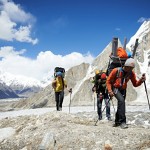The Whitechuck Glacier, Washington, USA, 1973 and again in 2006UKC Articles, Aug 2009© Neil Hinckley / Leor PantilatEs Tresidder is a regular UKC contributor and an environmental consultant. He has written a thought provoking article on climate change and the relationship between climbing and carbon emissions.UKC Article:Environmentalism and Climbing: An Uneasy PartnershipIn this article Es interviews several climbing companies and well known climbing figures, such as Yvon Chouinard fromPatagonia, as well as making his own case for reducing air travel in Europe.Mountainous areas will face glacier retreat, reduced snow cover and winter tourism, and extensive species losses (in some areas up to 60%) under high emissions scenarios by 2080.Intergovernmental Panel on Climate ChangeInstead of preaching that we should all cycle to Ceuse, Es takes a more realistic view of what is possible, what needs to be done and how we can do it; using real world examples of other climbers, skiers and mountain guides that have made a shift in their habits to a more sustainable lifestyle.He states: „Of all the things we do in climbing, travelling by plane has by far the biggest impact.“The overall message of the article is summed up nicely by Patagonia founderYvon Chouinard:?For me there's no difference between a pessimist who says; ?it's all over don't bother doing anything? and an optimist who says; ?oh it's all going to be fine don't bother doing anything?. Either way nothing gets done.?For those of you who are interested in travelling to the Alps this summer, Es has drawn a comparison table of carbon emissions – see below:Example Carbon Emissions – Travel to Chamonix
Read the full article: Environmentalism and Climbing: An Uneasy Partnership Other recent climbing Environmental reports:£30,000 in Environmental Awards From The CastleGreen Friday for the BMC The above table is based on the following assumptions:Average UK car CO2 emissions of 180g CO2/km (http://www.carpages.co.uk/co2/)Emissions from long-distance rail travel of 60g CO2 per passenger km (Defra)Emissions from air travel of 175g CO2 per passenger km (Defra), with a multiplying factor of 1.9 applied to take into account the other greenhouse gas emissions associated with aviation** * The figures for car use are per vehicle km, whereas for planes and trains they are per passenger km. This means that if you were to have 3 or more people in a car it would compete with train travel in CO2 emission terms.** Because air travel emits other greenhouse gases besides Carbon Dioxide, its contribution to climate change is greater than its CO2 emissions alone. Carbon calculator sites and offset schemes tend to ignore this. The IPCC use a multiplier of 1.9 to scale up the carbon dioxide emissions to take account of the full impact. Other agencies estimate the impact is much, much higher than this. The lack of consensus in this area stems from the fact that many of the gases emitted by aviation undergo changes in the atmosphere over their time. In the first year following the aviation emissions, the impact has been estimated as 36 times greater than that accounted for by counting the CO2 alone, falling to 3.7 times greater over a 20-year period. IPCC used to use 2.7 as their figure, but have updated this to 1.9, so I have followed suit here. If you feel the multiplier should be higher than this, feel free to apply a higher one! Diesen Artikel inkl. Bilder auf UKClimbing.com anschauen



![[VIDEO] Irmgard Braun: Record Breaking Rock Climber Who Gets Stronger Every Year Irmgard Braun: Record Breaking Rock Climber Who Gets Stronger Every Year (c) Hannah Morris Bouldering](https://www.climbing.de/wp-content/uploads/2025/11/youtube_MpAJEENfEjg-218x150.jpg)

![[VIDEO] The Challenge – Steve McClure The Challenge - Steve McClure (c) Petzl Sport](https://www.climbing.de/wp-content/uploads/2025/11/youtube_mfK9ynVsDvI-218x150.jpg)
![[VIDEO] Silence 9c/5.15d – The journey begins for Will Bosi Silence 9c/5.15d - The journey begins for Will Bosi (c) William Bosi](https://www.climbing.de/wp-content/uploads/2025/11/youtube_ujb7YRfE-7k-218x150.jpg)
![[VIDEO] Yosemite Crack Testpiece: Connor Herson on Magic Line Yosemite Crack Testpiece: Connor Herson on Magic Line (c) Fusis Films](https://www.climbing.de/wp-content/uploads/2025/10/youtube_h4GEt5iSZpA-218x150.jpg)
![[VIDEO] Hardest Trad Flash Ever | Adam Ondra | Lexicon E11 Hardest Trad Flash Ever | Adam Ondra | Lexicon E11 (c) Mammut](https://www.climbing.de/wp-content/uploads/2025/06/youtube_SAUyrDLG5xM-218x150.jpg)
![[VIDEO] IFSC Worldchampionship Bouldern Munich 2014 Saturday Semi Recap](https://www.climbing.de/wp-content/uploads/2014/12/vimeo_104175958-150x150.jpg)












